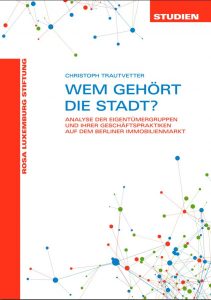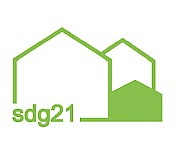 Half of the city of Berlin belongs to multimillionaires. This is the conclusion of the Rosa Luxemburg Foundation's current study entitled "Who owns the city? Analysis of owner groups and their business practices on the Berlin real estate market".
Half of the city of Berlin belongs to multimillionaires. This is the conclusion of the Rosa Luxemburg Foundation's current study entitled "Who owns the city? Analysis of owner groups and their business practices on the Berlin real estate market".
This is the first systematic evaluation of property ownership in Berlin and the various business models behind it. It opens the black box of large private property owners, about whom little has been known until now. The study describes hitherto unknown owners with more than 3,000 apartments as well as those who are below this threshold and about whom little is known so far.
"The study dispels the myth of the nice little private landlord as the main player in the real estate market, as well as the myth that selling condominiums to owner-occupants under current conditions contributes to social security and affordable housing," says study author Christoph Trautvetter, head of the Rosa Luxemburg Foundation's "Who owns the city?" project.
The uninterrupted price increases on the housing market bring the owners immense unearned returns of sometimes more than 20 percent a year. The study also compares business figures and practices of listed housing companies with their state-owned and cooperative counterparts.
"The sell-out of the city continues, although politically, especially by the Red-Red-Green Party, it is being resisted: for example, through the municipal right of first refusal, but also through the scandalisation of share deals and initiatives for more transparency. In the real estate market, both financial resources and access to information are very unevenly distributed. With its study on the disclosure of the ownership of real estate in Berlin, the Rosa-Luxemburg-Stiftung is doing important political education work and is thus providing actors with the tools they need to inform themselves and defend themselves against the sell-off of their city," says Daniela Trochowski, executive director of the Rosa-Luxemburg-Stiftung.
The trial will be held on November 10, 2020 at 6:00 p.m. via Livestream will be presented. Participants: Christoph Trautvetter (author of the study, project leader "RLS-Cities - Who owns the city?"), Daniela Trochowski (executive director of the Rosa Luxemburg Foundation), Carsten Schatz (co-chair of the parliamentary group DIE LINKE in the Berlin House of Representatives), Rouzbeh Taheri (representative of the IniForum Berlin and spokesperson for "Expropriating Deutsche Wohnen and Co"). Stefan Thimmel (Housing and Urban Policy Officer at the Rosa Luxemburg Foundation) will moderate.
Tenants can also contact www.wemgehoertdiestadt.de can dive into the data of the research with just a few clicks. The website contains further data on the owners presented in the study and on more than two hundred other players in the Berlin real estate market. It thus makes it easier for tenants to search for further clues about the homeowners on the basis of their address or the company they know.
Source: Rosa Luxemburg Foundation PM of 10.11.2020
Keywords:
Stock, DE-News, Research, New books and studies, News Blog Berlin, Affordable housing, City, Housing, Housing policy





